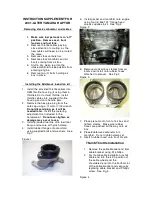
The autonomous braking function is available
in the following speed ranges:
R
from 7 km/h to approx. 105 km/h for mov-
ing objects
R
from 7 km/h to approx. 50 km/h for sta-
tionary objects
If the autonomous braking function demands
particularly high braking force, preventative
passenger protection measures (PRE-SAFE
®
)
are activated simultaneously.
Adaptive Brake Assist
i
Observe the "Important safety notes" sec-
tion (
Y
page 77).
Adaptive Brake Assist provides braking assis-
tance in hazardous situations at speeds
above 7 km/h. It uses radar sensor technol-
ogy to assess the traffic situation.
G
WARNING
Adaptive Brake Assist cannot always clearly
identify objects and complex traffic situa-
tions.
In such cases, Adaptive Brake Assist can:
R
intervene unnecessarily
R
not intervene
There is a risk of an accident.
Always pay careful attention to the traffic sit-
uation and be ready to brake. Terminate the
intervention in a non-critical driving situation.
G
WARNING
Adaptive Brake Assist does not react:
R
to people or animals
R
to oncoming vehicles
R
to crossing traffic
R
when cornering
As a result, the Adaptive Brake Assist may not
intervene in all critical conditions. There is a
risk of an accident.
Always pay careful attention to the traffic sit-
uation and be ready to brake.
Due to the nature of the system, particularly
complicated but non-critical driving condi-
tions may also cause Brake Assist to inter-
vene.
If Adaptive Brake Assist is not available due to
a malfunction in the radar sensor system, the
brake system remains available with full
brake boosting effect and BAS.
With the help of Adaptive Brake Assist, the
distance warning signal can detect obstacles
that are in the path of your vehicle for an
extended period of time.
If Adaptive Brake Assist detects a risk of col-
lision with the vehicle in front, it calculates
the braking force necessary to avoid a colli-
sion. If you apply the brakes forcefully, Adap-
tive Brake Assist will automatically increase
the braking force to a level suitable for the
traffic conditions.
X
Keep the brake pedal depressed until the
emergency braking situation is over.
ABS prevents the wheels from locking.
The brakes will work normally again if:
R
you release the brake pedal
R
there is no longer any danger of a collision
R
no obstacle is detected in front of your
vehicle
Adaptive Brake Assist is then deactivated.
If Adaptive Brake Assist demands particularly
high braking force, preventative passenger
protection measures (PRE-SAFE
®
) are activa-
ted simultaneously.
Up to a speed of approximately 250 km/h,
Adaptive Brake Assist is capable of reacting
to moving objects that have already been
detected as such at least once over the period
of observation.
Up to a speed of approximately 70 km/h,
Adaptive Brake Assist reacts to stationary
obstacles.
82
Driving safety systems
Sa
fet
y
Summary of Contents for E-Class Estate
Page 2: ......
Page 3: ......
Page 5: ......
Page 33: ...30 ...
Page 123: ...120 ...
Page 179: ...176 ...
Page 277: ...274 ...
Page 343: ...340 ...
Page 344: ...Useful information 342 Stowage areas 342 Features 360 341 Stowing and features ...
Page 379: ...376 ...
Page 380: ...Useful information 378 Engine compartment 378 Service 384 Care 385 377 Maintenance and care ...
Page 417: ...414 ...
Page 494: ...491 ...
Page 495: ...492 ...
Page 496: ......
Page 497: ......
















































